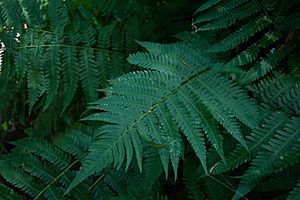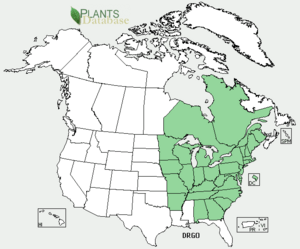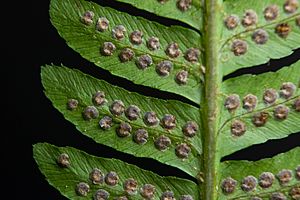Goldie's wood fern facts for kids
Quick facts for kids Goldie's wood fern |
|
|---|---|
 |
|
| Showing the distinctive short tapering leaf tip | |
| Conservation status | |
| Scientific classification | |
| Genus: |
Dryopteris
|
| Species: |
goldieana
|
 |
|
| Range within North America | |
| Synonyms | |
|
Aspidium goldieanum Hook. ex Goldie |
|
The Dryopteris goldieana, often called Goldie's wood fern or giant wood fern, is a large fern found in eastern United States and parts of Canada. You can find it from New Brunswick to Ontario and as far south as Georgia.
This fern is the biggest native Dryopteris species in North America. It's also one of the largest ferns in eastern North America, along with the ostrich fern. Some of these ferns can grow up to six feet (1.8 meters) tall! Goldie's wood fern can also mix with other types of Dryopteris ferns, and these mixed ferns often grow even larger than the original ones.
The fern was named by William Jackson Hooker to honor John Goldie, who first discovered it.
Contents
About Goldie's Wood Fern
Goldie's fern likes moist, rich woods, deep ravines, and the edges of swamps. It grows best in full or partial shade. These ferns grow in a clump, meaning all their leaves sprout from the same spot on the ground.
What the Fern Looks Like
The main stem of the fern, called the stipe, is covered in dark brown or black scales, especially near the bottom. This part of the stem doesn't have any leaflets. It makes up about one-third of the fern's total length. The stipe is dark brown at the base and turns green higher up. The part of the stem that holds the leaflets is called the axis, and it's green with pale scales.
The fern's leaves are quite thick, but they don't stay green all year. They can be dark green or even a golden-green color. These leaves can grow from 35 to 120 centimeters long and 15 to 40 centimeters wide. A special feature of this fern is its leaf tip, which tapers (gets narrower) quite suddenly. This helps tell it apart from other similar ferns. Sometimes, the leaf tip might even have white spots.
The main leaf is divided into many pairs of smaller leaves called leaflets. Most of these leaflets are simply divided, but some at the bottom might be divided twice. Each leaflet usually tapers at both ends and has a short stem connecting it to the main stem. These leaflets are further divided into even smaller parts called subleaflets. These subleaflets are oblong or oval-shaped, with a pointed tip and a toothed edge. They often curve slightly towards the tip of the main leaflet.
How Goldie's Fern Reproduces
Both the fertile (spore-bearing) and sterile (non-spore-bearing) leaflets look the same. The spores are found in small clusters called sori, which are usually located near the middle vein of the leaflet. Each sorus is covered by a smooth, kidney-shaped cover called an indusium.
Each fertile leaflet has about 6 to 8 pairs of sori, arranged on both sides of the midvein. In the middle of summer, the spores turn brown and become ready. They are then released into the wind to grow new ferns.
This fern is also one of the parent plants for other hybrid ferns, like Dryopteris celsa and Dryopteris clintoniana.
Growing Goldie's Wood Fern
If you want to grow Goldie's fern, it needs certain conditions to be healthy. It prefers medium sunlight or shade and a lot of humidity. The soil should be moist and full of organic matter, like compost. It also needs to be protected from strong winds.



